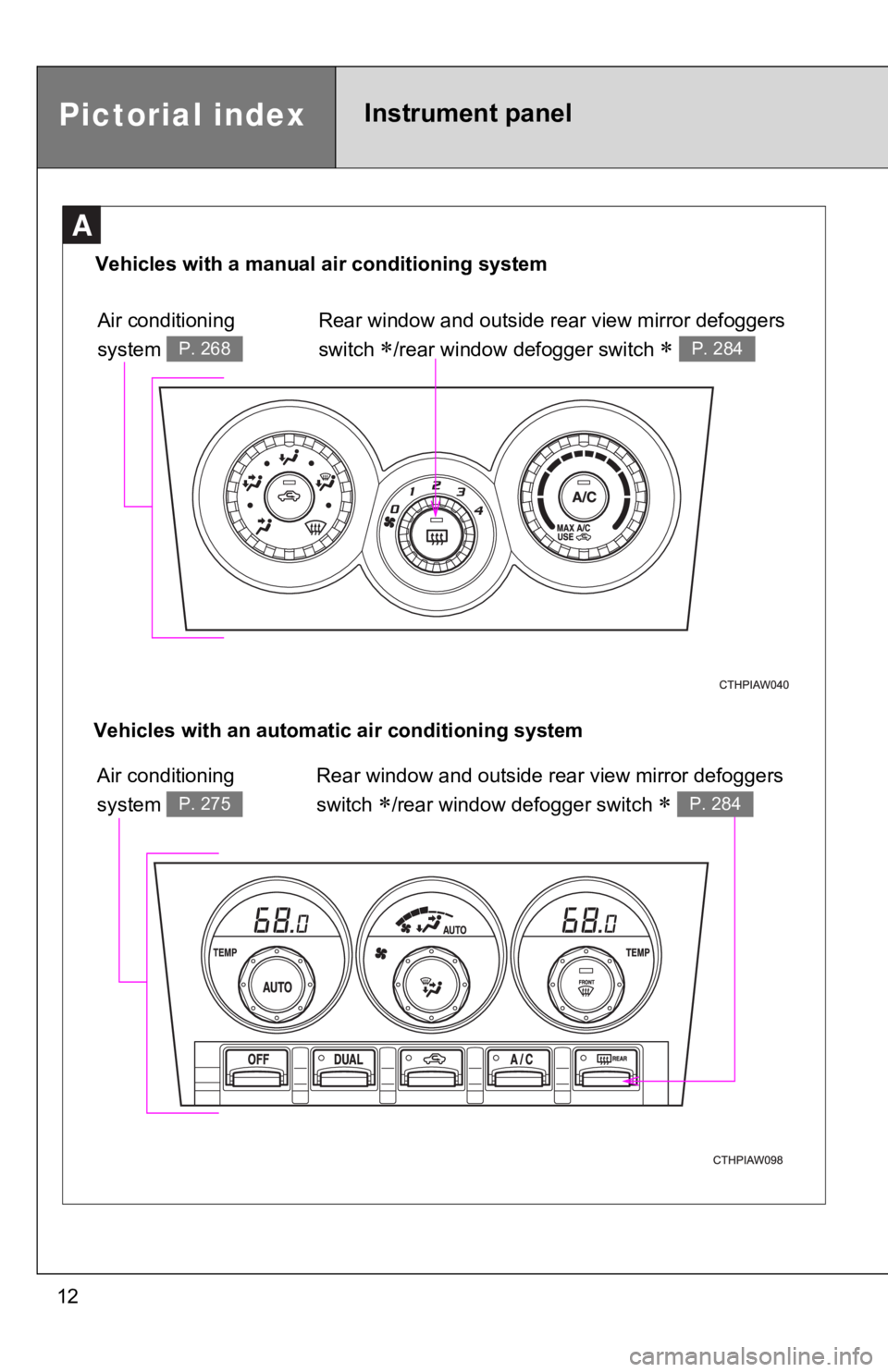air condition TOYOTA 86 2019 Owners Manual
[x] Cancel search | Manufacturer: TOYOTA, Model Year: 2019, Model line: 86, Model: TOYOTA 86 2019Pages: 532, PDF Size: 6.89 MB
Page 1 of 532

TABLE OF CONTENTS
11
Before driving Adjusting and operating features such as door locks,
mirrors, and steering column.
2
When driving Driving, stopping and safe-driving information.
3
Interior fea-
tures Air conditioning and audio systems, as well as other in-
terior features for a comfortable driving experience.
4
Maintenance
and care Cleaning and protecting your vehicle, performing do-it-
yourself maintenance, and maintenance information.
5
When trouble
arises What to do if the vehicle needs to be towed, gets a flat
tire, or is involved in an accident.
6
Vehicle
specifications Detailed vehicle information.
7
For owners Reporting safety defects for US owners, and seat belt
and SRS airbag instructions for Canadian owners
Index Alphabetical listing of information contained in this
manual.
Page 3 of 532

1
2
3
4
5
6
7
32-2. Instrument cluster
Gauges and meters ............ 191
Indicators and warning
lights ................................. 194
Multi-information display
(monochrome display) ...... 200
Multi-information display
(color display) ................... 207
2-3. Operating the lights
and windshield wipers
Headlight switch .................. 222
Fog light switch ................... 228
Windshield wipers and
washer .............................. 229
2-4. Using other driving
systems
Cruise control ...................... 232
Rear view monitor
system .............................. 237
Driving assist systems ........ 245
Hill-start assist control ......... 252
2-5. Driving information
Cargo and luggage ............. 256
Vehicle load limits ............... 260
Winter driving tips ............... 261
Trailer towing ...................... 265
Dinghy towing ..................... 266 3-1. Using the air conditioning
system and defogger
Manual air conditioning
system .............................. 268
Automatic air conditioning
system .............................. 275
Rear window and outside
rear view mirror
defoggers ......................... 284
3-2. Using the audio system
Using the AUX/USB port .... 286
Steering wheel audio
switches ........................... 287
Using the microphone ........ 288
3-3. Using the interior lights
Interior lights list ................. 289
• Interior light ...................... 290
3-4. Using the storage
features
List of storage features ....... 291
• Glove box ......................... 292
• Bottle holders ................... 293
• Cup holders/
console tray ...................... 2943
Interior features
Page 4 of 532

TABLE OF CONTENTS Index
43-5. Other interior features
Sun visors .......................... 296
Vanity mirrors ..................... 297
Clock .................................. 298
Power outlets ..................... 299
Seat heaters ....................... 301
Floor mat ............................ 303
4-1. Maintenance and care
Cleaning and protecting
the vehicle exterior ........... 308
Cleaning and protecting
the vehicle interior ............ 312
Cleaning and protecting
the Alcantara ®
area.......... 316
4-2. Maintenance
Maintenance
requirements .................... 318
General maintenance ......... 320
Emission inspection and
maintenance (I/M)
programs .......................... 323 4-3. Do-it-yourself
maintenance
Do-it-yourself service
precautions ....................... 324
Hood ................................... 327
Positioning a floor jack........ 329
Engine compartment .......... 331
Tires.................................... 345
Tire inflation pressure ......... 353
Wheels................................ 357
Air conditioning filter ........... 360
Wireless remote control/
electronic key battery ....... 363
Checking and replacing
fuses ................................. 367
Light bulbs .......................... 375
5-1. Essential information
Emergency flashers ............ 384
If your vehicle needs to
be towed ........................... 385
If you think something
is wrong ............................ 393
Fuel pump shut off
system .............................. 3944
Maintenance and care
5
When trouble arises
Page 12 of 532

12A Air conditioning
system P. 268
Rear window and outside rear view mirror defoggers
switch
/rear window defogger switch
P. 284
Pictorial index Instrument panelVehicles with a manual a ir conditioning system
Vehicles with an automati c air conditi oning system
Air conditioning
system P. 275
Rear window and outside r ear view mirror defoggers
switch
/rear window defogger switch
P. 284
Page 31 of 532

311-2. Opening, closing and locking the doors and trunk
1
Before driving ■ Conditions affecting operation
The smart key system uses weak radio waves. In the following si tuations,
the communication between the electronic key and the vehicle ma y be
affected, preventing the smart key system, wireless remote control and
engine immobilizer system from operating properly.
(Way of coping P. 440)
● When the electronic key battery is depleted
● Near a TV tower, electric power plant, gas station, radio stati on, large dis-
play, airport or other facility that generates strong radio wav es or electri-
cal noise
● When the electronic key is in contact with, or is covered by th e following
metallic objects
• Cards to which aluminum foil is attached
• Cigarette boxes that have aluminum foil inside
• Metallic wallets or bags
• Coins
• Hand warmers made of metal
• Media such as CDs and DVDs
● When other wireless keys (that emit radio waves) are being used nearby
● When carrying the electronic key together with the following de vices that
emit radio waves
• A portable radio, cellular phone, cordless phone or other wire less com-
munication device
• Another vehicle's electronic key or a wireless key that emits radio
waves
• Personal computers or personal digital assistants (PDAs)
• Digital audio players
• Portable game systems
● If window tint with a metallic content or metallic objects are attached to
the rear window
● When the electronic key is placed near a battery charger or electronic
devices
Page 41 of 532

411-2. Opening, closing and locking the doors and trunk
1
Before driving ■ Security feature
If a door is not opened within approximately 60 seconds after t he vehicle is
unlocked, the security feature automatically locks the vehicle again.
■ Alarm (vehicles with a smart key system)
Using the wireless remote control to lock the doors will set th e alarm system.
( P. 82)
■ Conditions affecting operation
Vehicles without a smart key system
The wireless remote control function may not operate normally i n the follow-
ing situations:
● When the wireless key battery is depleted
● Near a TV tower, electric power plant, gas station, radio stati on, large dis-
play, airport or other facility that generates strong radio wav es or electri-
cal noise
● When carrying a portable radio, cellular phone or other wireles s commu-
nication devices
● When the wireless key is in contact with, or is covered by a me tallic
object
● When other wireless key (that emit radio waves) is being used n earby
● If window tint with a metallic content or metallic objects are attached to
the rear window
Vehicles with a smart key system
P. 31
■ If the wireless remote control do es not operate properly (vehic les with
a smart key system)
Locking and unlocking the doors, unlocking the trunk: Use the m echanical
key. ( P. 440)
■ Key battery depletion
Vehicles without a smart key system
If the wireless remote control function does not operate, the b attery may be
depleted. Replace the battery when necessary. ( P. 363)
Vehicles with a smart key system
P. 35
Page 99 of 532

991-7. Safety information
1
Before driving Also, if luggage or electronic devices are placed on the front passenger’s
seat, this may adversely affect the ability of the system to de termine deploy-
ment. This may prevent the front passenger’s frontal airbag ON and OFF
indicators from working properly. Check that the indicators wor k properly.
When the OFF indicator turns off and the ON indicator illuminat es, the front
passenger’s frontal airbag may deploy during a collision. Remov e luggage
and electronic devices from the front passenger’s seat.
NOTE
This device complies with Part 18 of the FCC Rules. This device may cause
interference. If this device causes interference, consult the n earest Toyota
dealer. Also, for maintenance of the system, consult the neares t Toyota
dealer.
■ Conditions in which front passen ger’s SRS frontal airbag is not acti-
vated
The front passenger’s SRS frontal airbag will not be activated when any of
the following conditions are met regarding the front passenger’s seat:
● The seat is empty.
● The seat is equipped with an appropriate child restraint system and an
infant is restrained in it.
● The occupant changed their posture after the occupant load is j udged.
● The front passenger’s occupant classification system is malfunctioning.
WARNING
When the front passenger’s seat is occupied by an infant in an appropriate
child restraint system, observe the following precautions. Fail ure to do so may
interfere with the proper operation of the occupant classification system, acti-
vating the front passenger’s SRS frontal airbag even though tha t seat is occu-
pied by the infant in the child restraint system.
● Do not place any article (including electronic devices) on the seat other than
the infant in the child restraint system.
● Do not place more than one infant in the child restraint system .
Page 101 of 532

1011-7. Safety information
1
Before driving ● Ensure that no article is placed on the seat other than the occupant.
If the ON indicator still remains illuminated while the OFF indicator turns off
despite the fact that the actions noted above have been taken, seat the
child/small adult in the rear seat and immediately contact your Toyota dealer
for an inspection. Even if the system has passed the dealer ins pection, it is
recommended that on subsequent trips the child/small adult alwa ys take the
rear seat.
Children who have outgrown a child restraint system should alwa ys wear the
seat belt irrespective of whether the airbag is deactivated or activated.
■ Conditions in which fr ont passenger’s SRS frontal airbag is act ivated
The front passenger’s SRS frontal airbag will be activated for deployment
upon impact when any of the following conditions are met regard ing the front
passenger’s seat.
● When the seat is occupied by an adult.
● When a certain item(s) (e.g. jug of water) is placed on the seat.
Page 104 of 532

1041-7. Safety information
The SRS airbag can function only when the engine switch is in t he “ON”
position (vehicles without a smart key system) or when the “ENG INE START
STOP” switch is in IGNITION ON mode (vehicles with a smart key system).
The Toyota advanced frontal airbag system is designed to determ ine the
activation or deactivation condition of the front passenger’s S RS frontal air-
bag depending on the characteristic of the item(s) or person on the front
passenger’s seat monitored by the front passenger’s occupant cl assification
system sensor. For this reason, only the driver’s SRS frontal a irbag may
deploy in the event of a collision, but this does not mean fail ure of the sys-
tem.
If the front sub sensors and the impact sensors in the airbag c ontrol module
detect a predetermined amount of force during a frontal collisi on, the control
module sends signals to the airbag module(s) (only driver’s mod ule or both
driver’s and front passenger’s modules) instructing the module( s) to inflate
the SRS frontal airbag(s).
The driver’s and front passenger’s SRS frontal airbags use dual stage infla-
tors. The two inflators of each airbag are triggered either seq uentially or
simultaneously, depending on the severity of impact, in the cas e of the
driver’s SRS frontal airbag and depending on the severity of im pact and the
characteristic of the item(s) or person on the seat in the case of the front
passenger’s SRS frontal airbag.
After deployment, the SRS airbag immediately starts to deflate so that the
driver’s vision is not obstructed. The time required from detec ting impact to
the deflation of the SRS airbag after deployment is shorter tha n the blink of
an eye.
Both when only the driver’s SRS frontal airbag deploys and the driver’s and
front passenger’s SRS frontal airbags deploy, the driver’s and front passen-
ger’s seat belt pretensioners operate at the same time.
Although it is highly unlikely that the SRS airbag would activa te in a non-
accident situation, should it occur, the SRS airbag will deflat e quickly, not
obscuring vision and will not interfere with the driver's abili ty to maintain con-
trol of the vehicle.
When the SRS airbag deploys, a sudden, fairly loud inflation no ise will be
heard and some smoke will be released. These occurrences are a normal
result of the deployment. This smoke does not indicate a fire i n the vehicle.
Page 127 of 532

1271-7. Safety information
1
Before driving WARNING■ SRS warning light
If the warning light exhibits any of the following conditions, there may be a
malfunction in the seat belt pretensioners, SRS airbag system a nd/or front
passenger occupant classification system. Immediately take your vehicle to
your nearest Toyota dealer to have the system checked. Unless c hecked
and properly repaired, the seat belt pretensioners, SRS airbag and/or front
passenger occupant classification system will not operate prope rly in the
event of a collision, which may increase the risk of death or s erious injury.
● Flashing or flickering of the warning light
● No illumination of the warning light when the engine switch is first turned to
the “ON” position (vehicles without a smart key system), or the “ENGINE
START STOP” switch is turned to IGNITION ON mode (vehicles with a
smart key system).
● Continuous illumination of the warning light
● Illumination of the warning light while driving